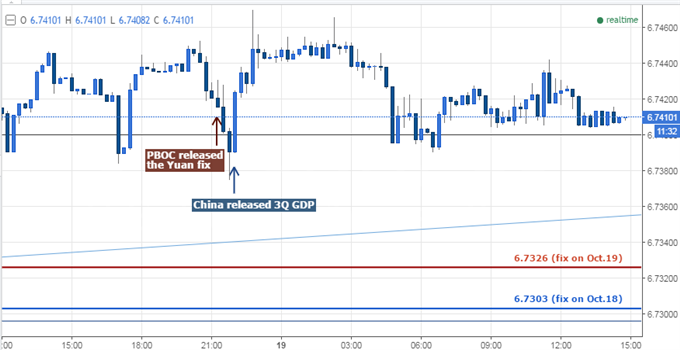This daily digest focuses on Yuan rates, major Chinese economic data, market sentiment, new developments in China’s foreign exchange policies, changes in financial market regulations, as well as market news typically available only in Chinese-language sources.
– China’s investment conditions improved in September, with a 2.5% growth in private investment.
– Both sales and investment in real estate picked up in September, increasing the risk of price bubbles.
– The PBOC Shanghai Branch demanded local commercial banks to tighten mortgage issuance.
Yuan Rates
– The PBOC weakened the Yuan by -23 pips against the U.S. Dollar to 6.7362 on Thursday. Following the release of the Yuan fix, the offshore Yuan strengthened against the Dollar and rose to the strongest level in three days, with the USD/CNH dipping 6.7375. This is likely because the offshore Yuan was trading below the guided level despite the drop in the fix. Forty five minutes later, China’s 3Q GDP print came in, showing a steady growth of 6.7%, in line with estimates. In an immediate response to the GDP read, the offshore Yuan fell against the Dollar. By the time this report was written, the Yuan recovered with the USD/CNH retracing around 6.7410.
USD/CNH 15-Minutes

Prepared by Renee Mu.
Key Economic Indicators
China’s investment conditions showed improvement in September, after two main measures hit all-time lows in August. The growth in fixed assets investment excluding rural (total investment) increased to 8.2% in September from 8.1% in the month prior; the growth in private investment in fixed assets (private investment) rose to 2.5% from 2.1% over the same span of time.
The investment prints are consistent with the money supply reads released yesterday.
The gap between the growth in M1 and M2 has narrowed to 13.2% in September
, indicating companies and individuals are spending more.
However, it may be too soon to say that Chinese companies’ investment has recovered, as the growth rates remained at relative low levels. Regulators are more likely to wait a bit longer in hopes of seeing more improvement in investment before make major changes in either monetary policy or fiscal policy.













Leave A Comment